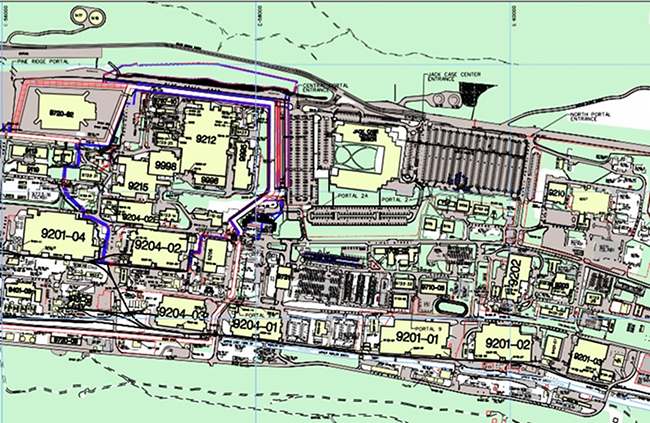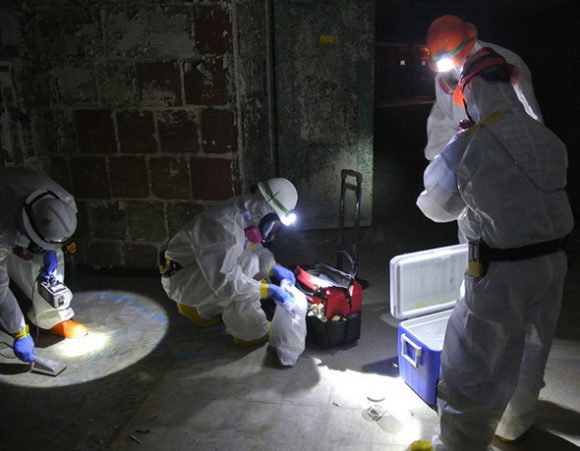
Federal officials have already approved the need for a new Lithium Production Facility at the Y-12 National Security Complex, and in May 2018, they said it could be built on the east side of the 811-acre plant, possibly where the Biology Complex, the brick building at center, is now. The east side of Y-12 is pictured above from Scarboro Road on Sunday, May 20, 2018. (Photo by John Huotari/Oak Ridge Today)
Federal officials have already approved the need for a new Lithium Production Facility at the Y-12 National Security Complex, and this month, they said it could be built on the east side of the 811-acre plant, possibly where the Biology Complex is now.
Current plans call for demolishing the Biology Complex. Officials had recently been saying that removing buildings from that complex would allow the area to be used for “modern national defense missions.” But it hadn’t been clear what those missions might be.
On May 12, Steven Wyatt, public affairs manager for the National Nuclear Security Administration Production Office, confirmed that the Lithium Production Facility could be built there. Y-12 is a NNSA site.
“We are in the early stages of planning for the Lithium Production Capability that is needed to replace the aging and obsolete 9204-2 building,” Wyatt said. “We are reviewing options for constructing a facility in the eastern portion of the Y-12 site, including the area of the Biology Complex.”
Oak Ridge Today reported in August that federal officials had approved the mission need for the new Lithium Production Facility. But the cost and schedule had not yet been determined. It’s not clear if that has changed.
“Y-12 is working to ensure that its lithium production capability is maintained for current and future defense program missions,” Wyatt said then. “This is a challenge, as this work is performed in 9204-2, a building that was constructed during World War II as part of the Manhattan Project. Ultimately, our goal is to replace 9204-2 with a modern facility, but until that has been achieved, we will continue to make improvements as needed.”
Building 9204-2 produces non-nuclear materials associated with stockpile stewardship missions, Wyatt said.
“We are not at liberty to provide any further details on this work,” he said.
The future Lithium Production Facility at Y-12 will produce non-nuclear materials. In August, Wyatt said he can’t elaborate.
Building 9204-2 is located within the Y-12 Protected Area, on the west side of the plant. Maintenance issues with Building 9204-02 include concrete repairs, upgrades and replacements of humidity control systems, upgrades to electrical systems and fire safety systems, and improvements to process equipment, Wyatt said.
Part of a concrete ceiling fell into a roped-off area of the building in March 2014, according to the Defense Nuclear Facilities Safety Board. In a 2009 inspection, engineers had noted signs of extensive corrosion of concrete and steel rebar caused by Kathene (aqueous lithium chloride) from a dehumidification unit on the floor above, the safety board said. No one was injured when chunks of concrete that reportedly weighed up to 200 pounds fell from the ceiling in March 2014, but the incident was cited by U.S. Rep. Chuck Fleischmann, a Republican whose district includes Oak Ridge, during a House subcommittee hearing that included testimony by Bruce Held, who was then acting administrator of the National Nuclear Security Administration.
Oak Ridge Today reported in August that some nuclear material work now being done in Building 9204-2 was being moved to Building 9204-2E, where critical infrastructure upgrades were announced in February 2015.
In May 2017, the DNFSB said Building 9204-2 is being downgraded to a non-nuclear facility. In January of this year, the DNFSB reported that Consolidated Nuclear Security, the contractor that manages and operates Y-12 for the NNSA, “continues to make progress in their effort to downgrade Building 9204-2 from a hazard category 2 nuclear facility.” In May 2017, CNS ceased fissile material operations in the facility, according to the safety board.
“CNS is currently working to fully implement the Building 9204-2 downgrade this summer,” the DNFSB said this January.
Over on the east side of the plant, the U.S. Department of Energy’s Oak Ridge Office of Environmental Management, or OREM, plans to demolish the Biology Complex. In March, Jay Mullis, manager of the DOE Oak Ridge Office of Environmental Management, said the federal spending bill approved that month included $639 million for the federal government’s cleanup program in Oak Ridge—and $125 million to deactivate and demolish the Biology Complex at Y-12.
The $125 million could be full funding for the top priority project because DOE officials expect the Biology Complex deactivation and demolition work to cost $125 million over three to four years. That means the earmarked money is expected to be enough to complete the project. The cleanup program can carry over the funds, meaning it doesn’t have to spend all of the money this fiscal year, which ends September 30.
The deactivation work includes asbestos abatement.
The Oak Ridge Office of Environmental Management announced in March that it had removed two higher-risk excess contaminated facilities at the complex: the Radiation Source Building and another one used for biological research. The buildings, which are owned by the DOE Office of Science at the NNSA site, had been vacant since 2000, and they had deteriorated due to their age.
“Removing the buildings allows the location to be used for modern national defense missions,” federal officials said in March.
Oak Ridge Today has submitted follow-up questions to the NNSA and plans to include that information in a news story later. The additional questions relate to project funding, the use of lithium, security requirements related to the proposed new production facility, and a rough cost estimate, size, and construction timeline.

Federal officials have already approved the need for a new Lithium Production Facility at the Y-12 National Security Complex, and in May 2018, they said it could be built on the east side of the 811-acre plant, possibly where the Biology Complex is now. The Biology Complex, which is on the east side of Y-12, is pictured above from Scarboro Road on Sunday, May 20, 2018. (Photo by John Huotari/Oak Ridge Today)
Now vacant, the Biology Complex was originally built to recover uranium from process streams. It later housed DOE’s research on the genetic effects of radiation from the late 1940s. It once housed more individuals with doctorates than anywhere in the world, according to the U.S. Department of Energy. DOE has said the men and women who worked there radically enhanced the world’s knowledge in biology, including the discovery of the Y chromosome.
The Biology Complex once consisted of 12 buildings, but four of them were demolished in 2010 as part of the American Recovery and Reinvestment Act, the stimulus package signed into law by President Barack Obama early in his presidency. Only six buildings remain after the additional two were demolished in March. The goal is to complete demolition in the early 2020s.
In April 2017, the Oak Ridge Office of Environmental Management and its cleanup contractor, URS | CH2M, or UCOR, finished characterizing the Biology Complex, identifying contaminants before demolishing and disposing of the buildings. DOE has said it was crucial to get crews into the complex before the working environment became too hazardous. Examples of hazards have included a failed roof, fallen exterior tiles, and asbestos and other risks due to roof leaks.
Last year, OREM said the Biology Complex would be a top priority if excess federal funding for site cleanup were available.
Y-12’s missions include work on nuclear weapons, retrieving and storing nuclear materials, and helping to provide fuel for the nation’s naval reactors.
More information will be added as it becomes available.
Crew members prepare samples for shipment to the laboratory for analysis from inside the Biology Complex at Y-12 National Security Complex. (Photo courtesy U.S. Department of Energy)

The new Lithium Production Facility at the Y-12 National Security Complex could be built where the Biology Complex is now in the area on the east side of the plant and pictured above at upper right (you may be able to see one building numbered 9210 to the east of a parking lot at center-right and the Jack Case Center at top-center), and it would replace Building 9204-02 on the west side of the plant, close to the left of the image above. (Map courtesy CNS Y-12)
Do you appreciate this story or our work in general? If so, please consider a monthly subscription to Oak Ridge Today. See our Subscribe page here. Thank you for reading Oak Ridge Today.
Copyright 2017 Oak Ridge Today. All rights reserved. This material may not be published, broadcast, rewritten, or redistributed.


Leave a Reply